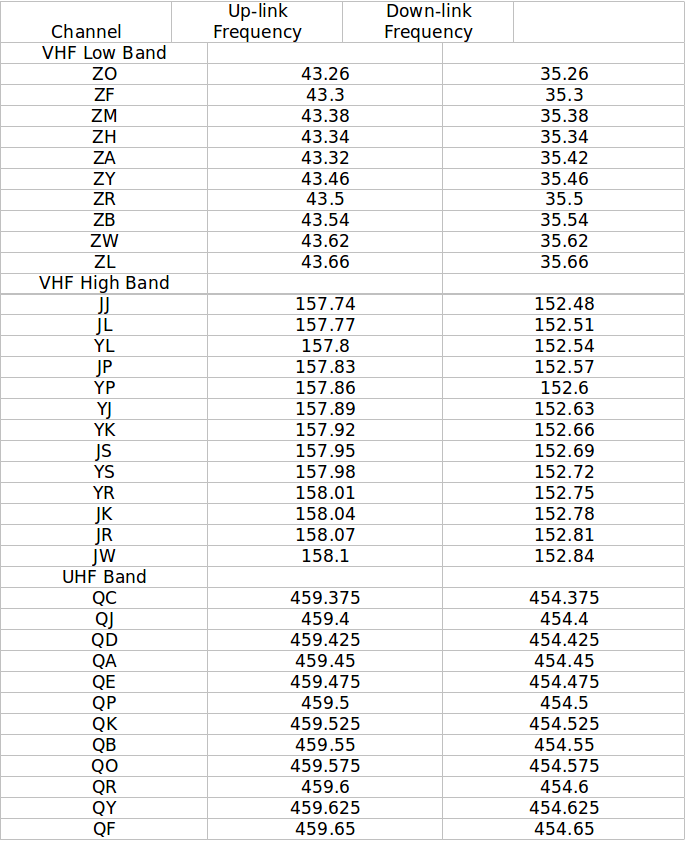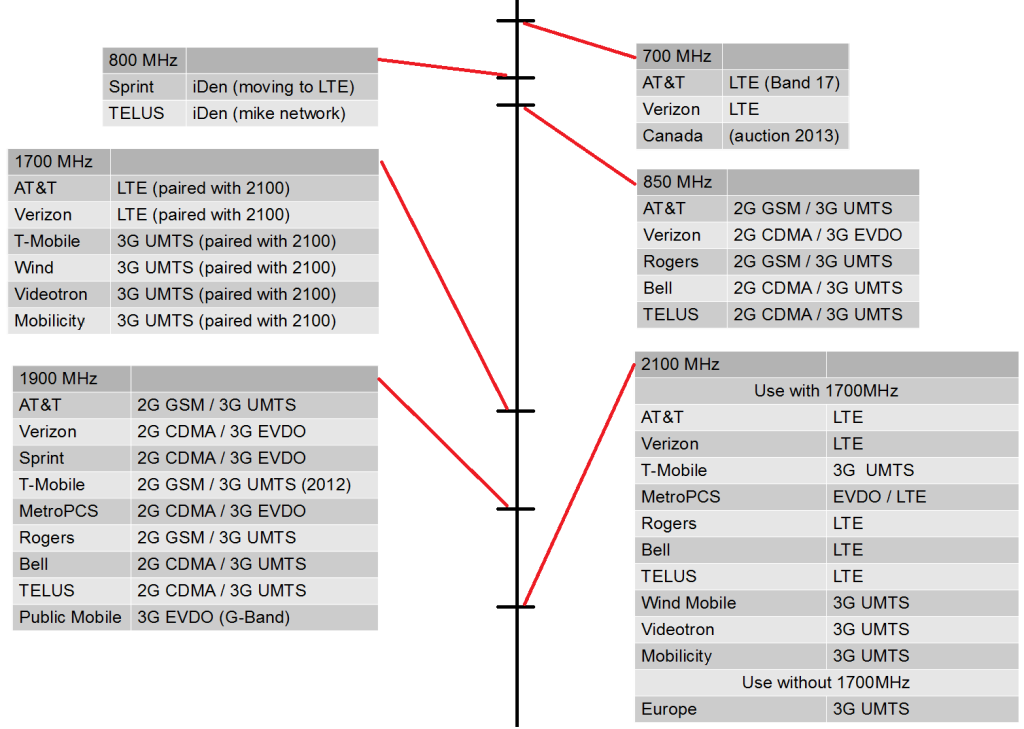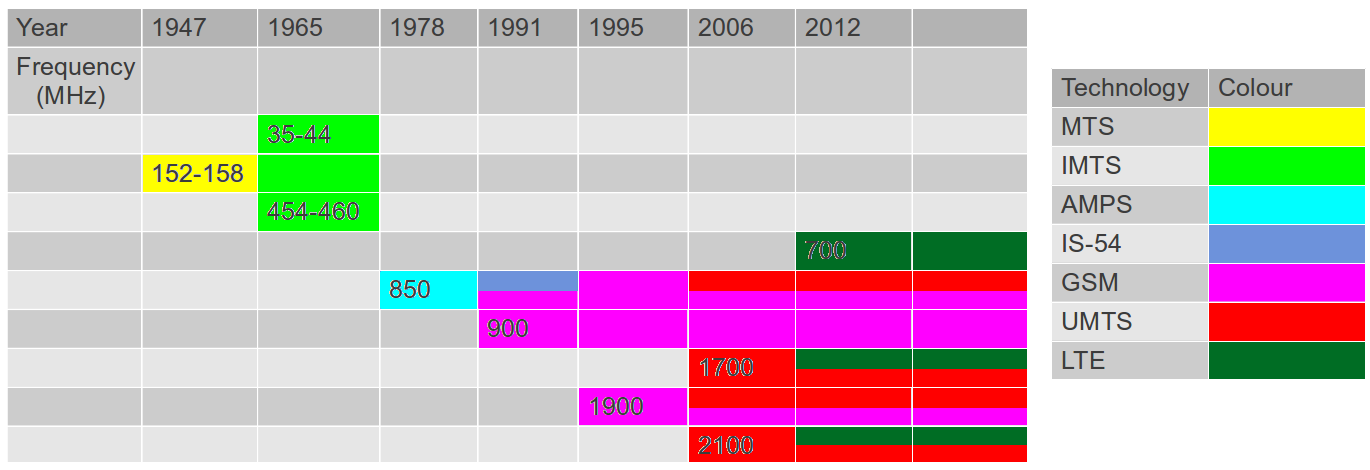Radio Frequency spectrum is one of the fundamental components necessary for the deployment of mobile telecommunication networks. This paper will discuss the development, evolution, and future plans of spectrum use relating to mobile telephony and data.
- INTRODUCTION
The ability to make networked voice communication interactions from a mobile device has been around, in its most fundamental form, since 1947. This technology has gone through many iteration, and advancements over the years, often necessitated be a chance in the way the technology was being used and the number of people using it. Having started off as a base-station oriented analog radio network designed for voice communication this technology has evolved into its modern form which not only is capable of voice communication, but also text messages and mobile data. These changes have made not only a profound impact on the type of devices being used by people today but also the infrastructure technology needed to support these devices. Among the requirements of a growing wireless market is access to increased amounts of, and more efficiently used, RF spectrum. This paper will attempt to cover the different interactions of mobile telephony technology, the spectrum used by each technology, the advantages and shot-falls of the spectrum used, alterations made over previous variants, and possibly solutions to the spectrum congestion issues. In this paper there will be no attempt made to identify the best mobile spectrum as each band has advantages and disadvantages, and not every use has the same spectral requirements. As such this paper will only attempt to make comparisons within each implementation and generally conclusions about implementation of mobile telephony as a whole.
This paper will cover the wire range of mobile telephony technologies, past and present, including Mobile Telephone Service (MTS), Improved Mobile Telephone Service (IMTS), AMPS, IS-54, GSM, UMTS, and LTE, and their interaction with spectrum.
- Second section
In 1947 Bell Labs introduced the first commercial radio-based system for telecommunication. The system, called Mobile Telephone Service (MTS), was a VHF radio network which connected the user to the Public Switched Telephone Network (PSTN). MTS operated as a base-station oriented system, similar in concept to landlines but using RF communication for the connection. The system started off using only 3 channels but was later expanded to 12, and then 24 as demand increased. In North America there were a total of 25 VHF channels used by MTS. The basic 12 channels were sub-divided so as to include channels in between, bringing the total to 24 in the US, and 25 in Canada where there was access to one preceding channel. Each channel was designated a 2 letter combination based on its position on a rotary telephone dial. MTS operates on two frequency bands, 152.48-152.84 for up-link (device to network), and 157.74-158.999 for down-link (network to device). Each channel was separated by 14.4KHz on the up-link and 50.36KHz on the down-link.
Table. 1. MTS Channels
The biggest issue encountered with MTS was congestion caused by the limitation of only being able to use one device on each of the 24 channels at any given time. In larger metropolitan areas the ability to only operate 24 devices at once was a huge problem, and was one of the reasons this system could not go into widespread use. In cities this technology has all but disappeared with it being replaced quickly by modern cellular networks. In Northern Canada Northwestel still operates many base stations in rural ares and still covers most of the Yukon, the northern BC highway network, western Great Slave Lake, and the Mackenzie River. The most common replacement for MTS service in rural areas has been satellite phones as they do not rely on a terrestrial network to operate.
- IMTS
In 1964 Bell Labs introduced the Improved Mobile Telephone Service (IMTS) as the replacement for MTS. IMTS is considered a 0G, pre-cellular, mixed VHF/UHF radio technology. IMTS operates in a similar manner to that of MTS in that it relies on a centralized base station to coordinate communication. The system made use of three frequency bands: VHF Low with 9 channels between 35-44MHz, VHF High with 11 (13 in Canada) channels 152-158MHz, and UHF with 12 channels between 454-460MHz. Due to the increase in the placement height of the towers, as well as more powerful transmitters, IMTS base stations were able to operate over a 40-60mi radius. Base stations in urban centers could operate up to 7 or 8 channels while rural stations would usually only operate one or two. The three bands, each had a letter prefix, Z, Y, and Q, for VHF Low, VHF High, and UHF respectively. As with MTS, VHF High channels JJ, and JW were only available for use in Canada.
Table. 2. IMTS Channel Frequencies.
Severe restrictions on the number of possible subscribers, similar to MTS, resulted in 3 year long waiting lists to get a telephone on this system. As such, the adoption of the technology was superficial and all but disappeared with the advent of modern cellular networks.
- AMPS
With the increase in demand for mobile telecommunication solutions, and IMTS not being able to provide a practical solution to the problem, the concept of modern cell networks was developed. A cellular network consisted of a back-end network of devices which connected each separate tower to the telephone network, a series of towers spread out over the operational area which the phones connected too, and transfered between, and the phones themselves which talked to the closest tower they were connected to. The first commercial implementation of this system came in 1978 in the form of the Advanced Mobile Phone System (AMPS) which was developed by Bell labs and using Motorola handsets. AMPS operated on the 850MHz cellular frequency band where (in the US) the FCC allowed an A and B license in each operating area. Each license used a specific block of frequency consisting of 21 control channels, each capable of 395 voice channels. With the introduction of the first networks in 1983 each carrier was alloted the use of 333 channels (with 666 available in total). With the increase in demand and number of subscribers the FCC expanded the system to 416 channels (832 total) through the re-purposing of UHF TV channels 70-83. For each of the 416 channels there were two frequencies, the up-link in the 824-849MHz range, the down-link in the 869-894MHz range, with a total for each voice duplexed channel of 60KHz, 30KHz each way. Unfortunately adjacent cell towers using different areas of the band to avoid interference with each other, caused a significant reduction of the real-world availability of channels. Though AMPS was to be phased out with the introduction of D-AMPS, CDMA and GSM its use of the 850 MHz band went on to become the foundation for most GSM networks works-wide.
- IS-54 and GSM
With the great success of AMPS, there was a demand for a better solution capable of handling the increasing number of devices on the networks. With AMPS being the most prolific of the available 1G standards it was the logical basis for the next generation mobile phone system. This new technology came in the form of D-AMPS, which was a re-engineered digital implementation along the same lines of the original AMPS system. D-AMPS (in the form of IS-54), released in 1990, was the first 2G standard on the market. IS-54 was modulated such that each device use a small time slot on its channel to transmit allowing for a tripling of the network capacity over the original AMPS. IS-54 was backwards compatible with the AMPS system and thus used the same 30KHz channel spacing as AMPS. In 1994 the FCC opened up the use of the PCS 1900MHz frequency band for use exclusively by digital devices. PCS, like the 850Mhz band, was duplexed, allowing for up-link using 1850-1910Mhz and down-link using 1930-1990MHz. This introduction of new spectrum was the first step towards the diverse array of different bands in use today, which allowed an increased number of companies, and consumers, to make use of this new technology. IS-54 was the first stepping stone towards the modern digital wireless networks of today and fed directly into the transition to Global System Mobile (GSM) which has been the standard for mobile communication for the past decade. After the transition away from AMPS and analog networks the 850MHz band was able to be used for GSM as well. With this transition complete in 2002, GSM was now utilizing the 850 and 1900MHz bands in North America, and 900Mhz in Europe, where 850 is used for Industry, Scientific, and Medical (ISM).
- UMTS
With the transition to mobile forms of communication, and the growing reliance on connecting to the Internet on a mobile device, the increase in demand for mobile spectrum was inevitable.
UMTS, classified as a form of 3G, is the most common form of high speed mobile phone communication technology. It builds on GSM (and is backwards compatible), but make some modulation upgrades to allow for more connections and faster throughput. 3G technology is one of the most diverse systems on the market today and makes use of the 850, 1900, 1700 and 2100MHz (duplexed) bands in North America, and 900, and 2100MHz bands in Europe. 3G brought about the introduction of two new wireless spectrum bands to the world of mobile telecommunication, (1700 and 2100Mhz in North America), and 2100MHz in Europe.
In Europe, the use of 2100 MHz was the next step in their roll-out of mobile communication and is the main frequency for 3G communication across Europe. In North America, the Advanced Wireless Service (AWS) band was designed to be a much more comprehensive upgrade with two completely separate duplexed bands, with up-link on 1710-1755Mhz and down-link on 2110-2155Mhz. The auction for this spectrum in North America was one of the most important to date as it was the first major spectrum sale since the beginning of wide-spread adoption. In the US, this auction took place in 2006 and resulted in most carriers getting at least some of the spectrum, all with plans to either us it for 3G (in the case of T-Mobile) or for use with 4G/LTE (in the case of AT&T).
Fig. 1. Carrier Spectrum use in North America.
The AWS spectrum auction in Canada was one of the most profound moments in mobile communication on the last 10 years. This new spectrum would not only be the first new spectrum introduction in many years but also the first time spectrum was being set aside for new entrants into the wireless market, something with the potential to cause a serious shake-up of the present wireless landscape. The country was divided into different geographical market areas, each of which had frequency blocks A through G. A, B, C, and D are 20MHz wide blocks while E, F and G are only 10 MHz. While in most markets the lucrative 20MHz blocks were snatched up by Rogers/Bell/Telus (ROBELUS) and a smattering of established regional carriers not all the spectrum was spoken for. The remaining spectrum was to be available for the “new entrants”, which included Wind Mobile, Mobilicity, Public Mobile, Eastlink, Videotron, and Shaw. The new entrants, with only 10MHz in most markets, are using the bare minimum that you can feasibly use to deploy a network, while the incumbent carriers have a lot more spectrum to work with, both in terms of these new blocks as well as their pre-existing spectrum. This will limit the expansion of these new carriers in the long run and will cause them to either bid on more spectrum in the upcoming 700MHz auction, or form a merger/spectrum sharing agreement.
- Problems with current spectrum use
The biggest problem with the way cellular spectrum is currently allocated is it is the result of many years of ineffective policy making by regulatory bodies around the globe and spanning multiple decades. This has resulted in the fragmented market we are dealing with today where there are 4 2G frequency bands running one of two different technologies, 5 3G bands each running one of 2 different technologies, and up to 13 possible 4G/LTE bands each possibly running one of 5 or more different technologies. Though this diversity allows for more subscribers and that no one band is being relied on to provide cell service, it also means that the lack of continuity and interoperability of networks both worldwide and even within a country, is becoming increasingly more difficult. With the rate at which people upgrade devices, and the speed at which carriers are able to upgrade their network, there will always be carriers around the world that choose to support older technologies. This can mean the spectrum that could be put to better us is stagnating and causing inefficiencies.
- Future of wireless spectrum use
There is no perfect solution for the future of wireless spectrum use, and with the ever changing capabilities of the technologies that use these bands we are discovering new and more efficient ways of using what we have at our disposal today. New modulation techniques have allowed us to move more traffic onto more channels places closer together, improve data throughput, and increase range. This change will result in the allocation of new bands in the near and distant future.
In the US there were recently auctions for new spectrum in the 2600 and 700 MHz frequency bands. The 700MHz band, considered the more lucrative of the two auctioned frequency bands, was recently re-farmed from the closure of analog TV channels 59-69 in the UHF band. As Analog TV channels are significantly less spectrally efficient they require substantially more bandwidth than the digital channels. The remaining TV channels, having been relocated to lower frequencies, means that the 700MHz band became available for mobile telecommunication. This band is of particular importance to the cellular carriers because, like the 850MHz band, it sits in a spectral sweet spot where the data though-put potential is still not a limitation, but is at a much lower frequency than the 1700-2100MHz bands, and thus much less susceptible to building penetration constraints. The following is a chart outlining the introductions, changes, and current usage of cellular wireless spectrum:
Fig. 2. Wireless Spectrum use past and present.
The introduction of the 700 and 2600MHz bands for use with LTE brings both advantage and disadvantages. Carriers planning to build out LTE networks will do so on these newly released bands while carriers currently using AWS for LTE (AT&T, Rogers, Bell, TELUS) will all continue to do so. As 2G fades into obsolescence its use on 850 and 1900 (and 900 in Europe) will decrease accordingly. This will mean that in 10 years time this spectrum will again be recycled and become available for use with some new technology.
When it comes to free market forces in the context of utilities, telecommunication infrastructure has always been at the trailing edge. With startup investment being extremely high and the monopolistic ownership of the market by a few key players, it is extremely hard for new companies to break into this closed system. This holds very much true for wireless spectrum, and has been the cause of extremely high wireless prices in North America. One proposed solution to this problem is rather than selling the spectrum to companies, lease it to them. Thus. if they are not making full use of it, or practicing uncompetitive behaviour, the spectrum can be transfered to someone who will utilise it to its full potential.
- Conclusions
With wireless spectrum as the backbone of our modern world through our use of mobile communication the need for proper regulation of the spectrum being used, and planned, is of utmost importance. Unfortunately there is still the ever-present issue of dealing with legacy spectrum assignment, which is almost impossible to mitigate, and further highlights the need for proper spectral planning. This paper has outlined the beginnings of wireless telecommunication spectrum use, how it has evolved over the years, and where it is headed going forward. With no master plan, or ideal solution, one can only attempt to make the best of the complicated situation that is at hand, deal with it in a swift, stable manner, and most importantly, ensure future sustainability of this precious commodity.
REFERENCES
Federal Communication Commission. 2006. Advances Wireless Services (AWS) Band Plan. Retrieved March 1, 2013 from http://wireless.fcc.gov/services/aws/data/awsbandplan.pdf
Federal Communication Commission. 2011. Broadband Personal Communication Service (PCS). Retrieved March 1, from http://www.fcc.gov/encyclopedia/broadband-personal-communications-service-pcs
Industry Canada. 2013. Auction of Spectrum Licences for Advanced Wireless Services and Other Spectrum in the 2 GHz Range. Retrieved March1, from http://www.ic.gc.ca/eic/site/smt-gst.nsf/eng/h_sf08891.html
Long Distance Post. 2013. History of GSM and More. Retrieved on March 1, 2013 from http://www.ldpost.com/telecom-articles/History-of-GSM-and-More.html
Tom Farley and Mark van der Hoek. 2006. Digital Wireless Basics: “1990′s”. Retrieved March 1, 2013 from http://www.privateline.com/mt_digitalbasics/2006/01/1990s.html
AT&T. 2011. Testing the First Public Cell Phone Network. Retrieved March 1, 2013 from http://techchannel.att.com/play-video.cfm/2011/6/13/AT&T-Archives-AMPS:-coming-of-age
Geoffrey C. Fors. 2012. Retrieved on March1, 2013 from http://www.wb6nvh.com/MTSfiles/Carphone1.htm
Federal Communication Commission. 2006. Code of Federal Telecommunication Regulations. Retrieved on March 1, 2013 from http://www.gpo.gov/fdsys/pkg/CFR-2006-title47-vol1/pdf/CFR-2006-title47-vol1.pdf
Radio Raider. 2013. Cellular UMTS Frequencies. Retrieved March , 2013 from http://www.radioraiders.com/umts-frequency.php
Industry Canada. 2008. Radio Spectrum Allocations in Canada. Retrieved on March 1, 2013 from http://www.ic.gc.ca/eic/site/smt-gst.nsf/vwapj/spectallocation-08.pdf/$FILE/spectallocation-08.pdf
Federal Communication Commission. 2013. FCC Online Table of Frequency Allocations. Retrieved on March1, 2013 from http://transition.fcc.gov/oet/spectrum/table/fcctable.pdf



